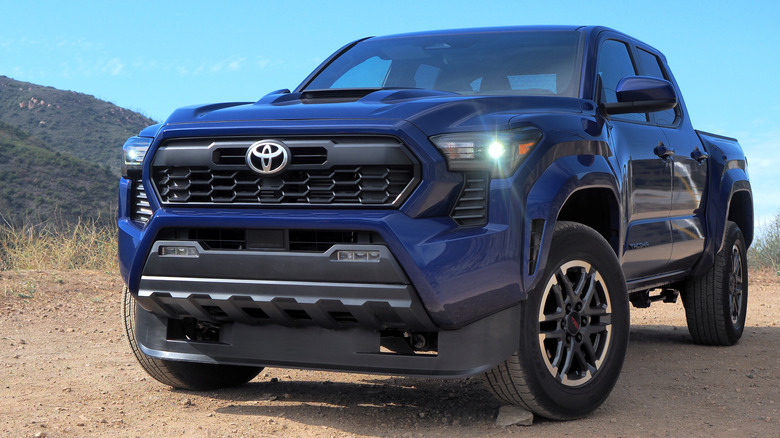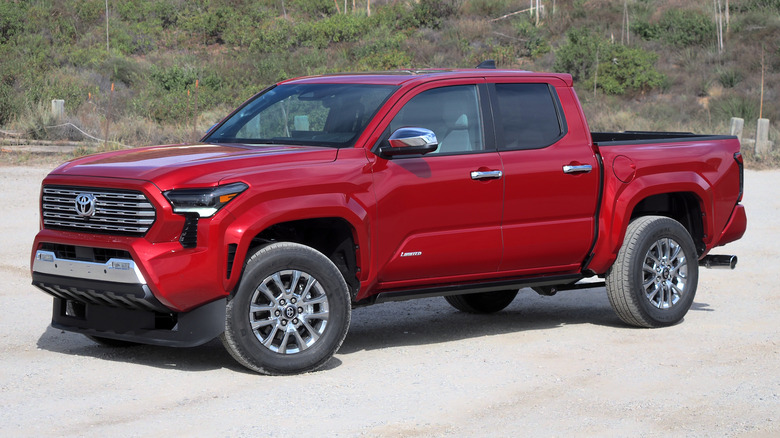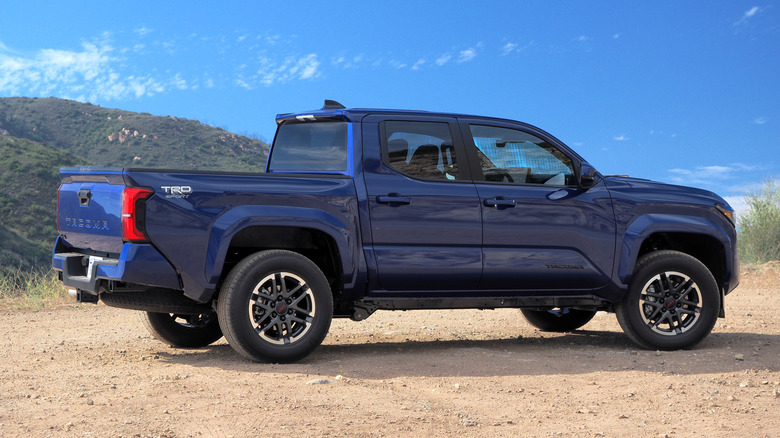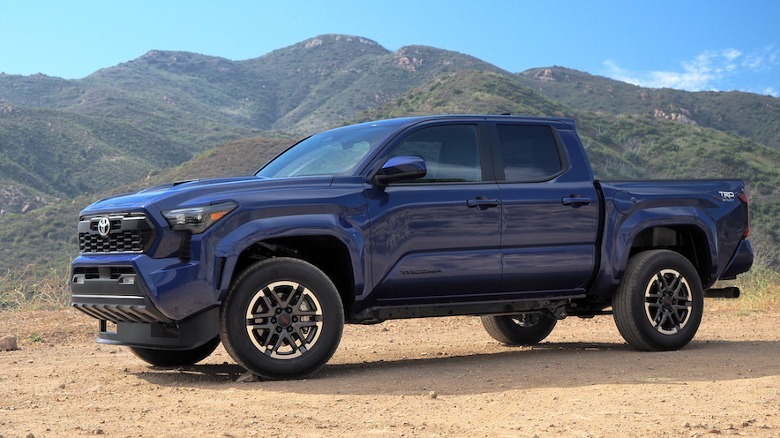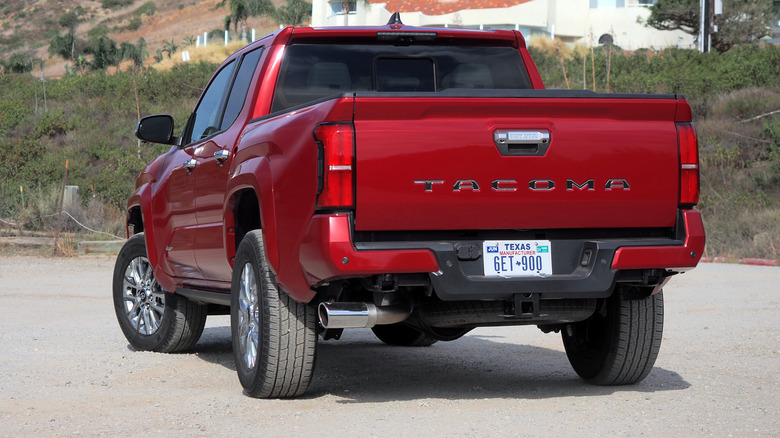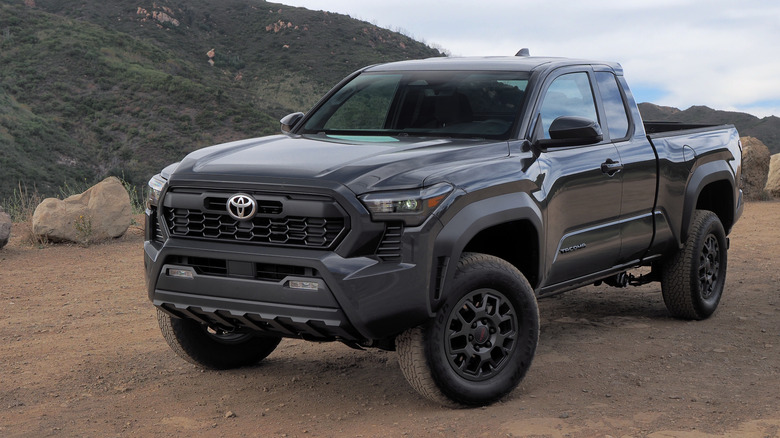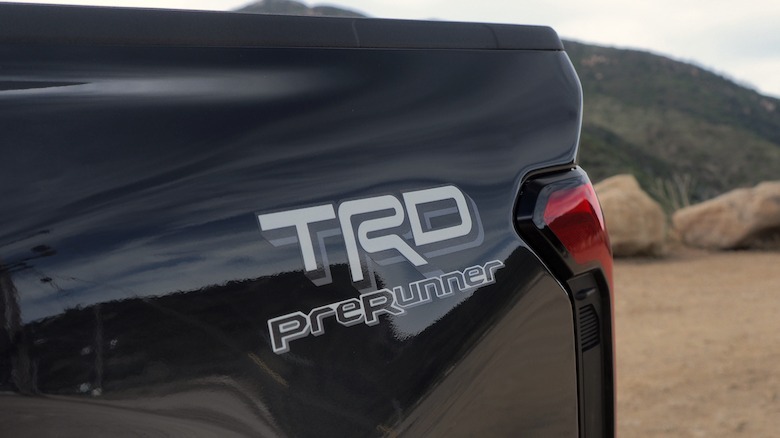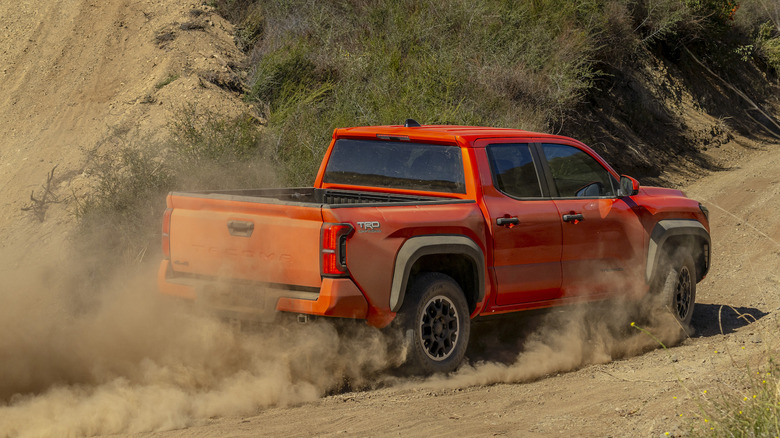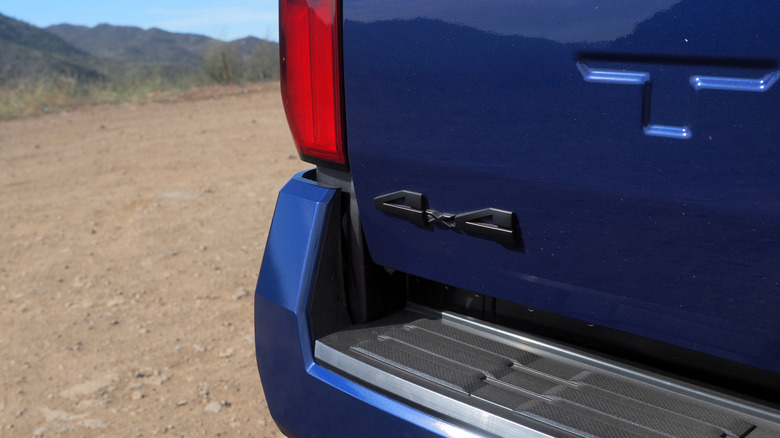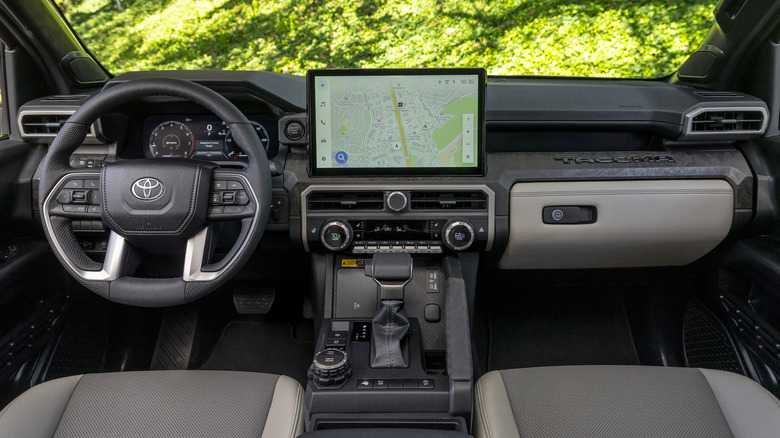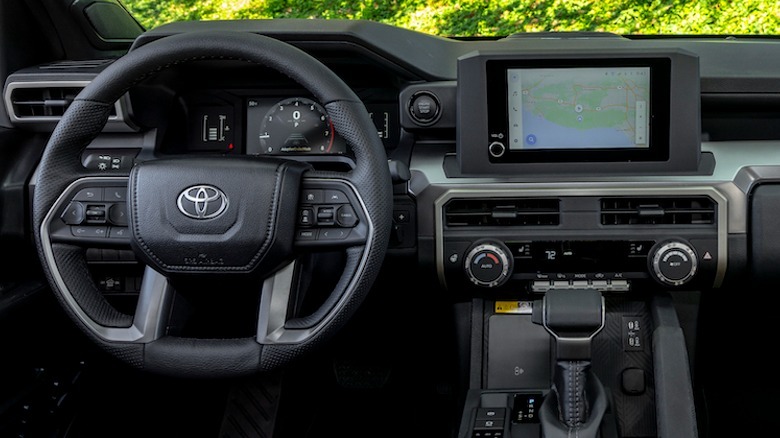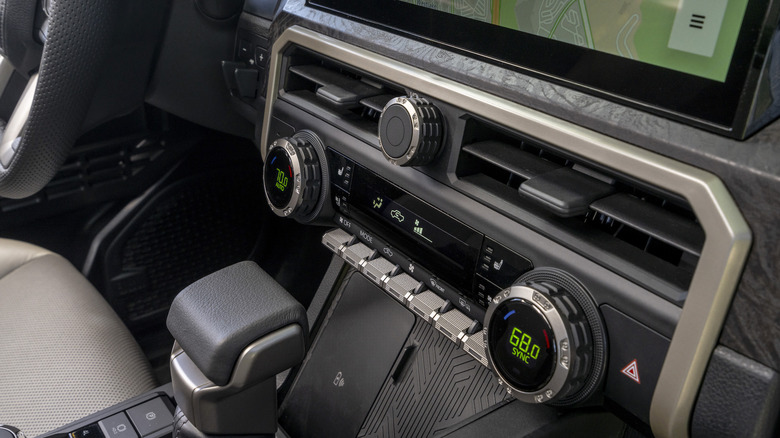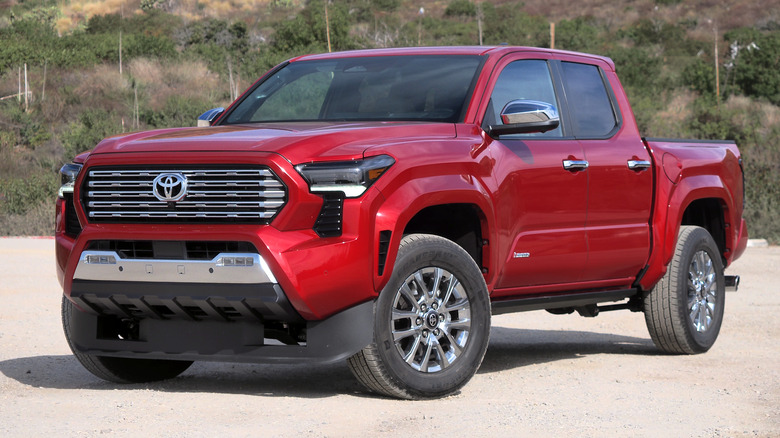2024 Toyota Tacoma First Drive: Midsize Truck Aims For The Impossible
Toyota's strategy of "don't mess with a good thing" has come to an end, and that makes the 2024 Tacoma all the more risky. When it arrives in U.S. dealerships this December, the fourth-generation truck will arguably deliver the biggest upgrade the midsize pickup has seen since its debut. In the process, however, Toyota finds itself walking a narrow line between the expectations of long-time Tacoma owners and the demands of modern truck buyers.
For all its sales success in recent years, though, the allure of the Tacoma has been something of a head-scratcher. Fans of the pickup have rightly praised its off-road talents and affordability. Still, anybody cross-shopping with rivals like the Ford Ranger, Chevrolet Colorado, or Honda Ridgeline would be forgiven for questioning what century the Toyota came from.
The new Tacoma challenge, then, is straightforward in principle and considerable in practice: take a beloved truck and give it a tech and refinement glow-up, without sacrificing its core abilities (and thus its enduring appeal) in the process. Oh, and preferably without blowing the budget, too.
Do you want sturdy, swollen, or shiny?
With its U.S.-based design studio taking the lead, the 2024 Tacoma is unsurprisingly styled with American tastes in mind. That means a bigger, bolder front, a pinched midsection, and swollen fenders. Lower trims get plenty of black plastic cladding and 17-inch wheels, as well as LED headlights and daytime running lights (DRLs).
The TRD Sport kicks things up with 18-inch wheels and LED fog lights, while the TRD Off-Road swaps in 17-inch machined alloy wheels shod in all-terrain tires. By the time you reach the 2024 Tacoma Limited, most of the plastic is swapped for body-color cladding, there's plenty of glittering chrome — including 18-inch chrome-finished alloy wheels — and color-keyed bumpers.
The only stand-out head-scratcher is the lower fascia trim on the road-centric grades: a deep, black plastic slab hung underneath the front bumper. Toyota is blunt that it's a fuel economy thing, even if it's only expected to contribute a fraction of a point on the MPG rating. The automaker's engineers are equally upfront about the fact that it's held on by nine readily accessible bolts.
Two engines (eventually)
Toyota's base engine is a 2.4-liter turbocharged four-cylinder dubbed i-FORCE, with three levels of tune, a choice of either an eight-speed automatic or a six-speed manual transmission (trim-depending), and either 4x2 or 4x4 drive. At its mildest in the SR trim, it offers 228 horsepower and 243 pound-foot of torque, with either the auto or manual gearbox. More potent versions land with either 278 hp and 317 pound-foot or 270 hp and 310 lb-ft. Economy ranges from 18 to 21 mpg combined, depending on drivetrain and transmission.
Meanwhile, in the pipeline is the 2024 Tacoma's flagship powertrain: the i-FORCE MAX. As we've seen in other Toyota trucks, that's a four-cylinder turbocharged hybrid, here with 326 horsepower and 465 pound-foot of torque. It'll only be offered in a 4x4 Double Cab configuration and is expected to follow on in dealerships in spring of 2024; pricing will be confirmed closer to that point.
Toyota's XtraCab two-door has seating for two, while the Double Cab adds a three-seater rear bench with an uptick in storage space underneath it. There are two bed lengths — 5 feet and 6 feet — and up to 6,500 pounds of towing capacity (trim-depending) and between 1,230 and 1,705 pounds of payload capacity (trim-depending).
A new platform brings much-needed refinement
Underpinning the new Tacoma is Toyota's TNGA-F global truck platform, the same which is found on the Sequoia, Tundra, and the upcoming 2024 Land Cruiser. The automaker says it's not only stiffer — thanks to things like lashings of high-strength steel and laser welding — but taps more aluminum in the upper body to trim weight.
It's not the only upgrade you don't instantly see but will appreciate over time, mind. While the leaf springs of the old Tacoma are still used on the workhorse SR, SR5 XtraCab, and TRD PreRunner grades, other versions of the truck get multi-link rear coil suspension. Disc brakes are now standard across the board, along with electric power steering.
The result, Toyota promises, is a truck that feels much more like a daily driver. While the old pickup was no slouch off-road, its on-road manners were fairly agricultural, which had become even more apparent with the arrival of newer rivals from Chevrolet, Ford, and others. For the 2024 Tacoma, Toyota is aiming to reset the balance.
On-road improvements are impressive
The good news is that it works. Where the old Tacoma bounces and twists, the new multi-link suspension leaves the new truck feeling far more refined and comfortable. Highway joins are no longer a shortcut to lurching; poor-quality asphalt won't leave you jostled and cursing. Better sound insulation on the Limited grade makes a significant contribution, too, something anybody who has made an extended drive in an older Tacoma will definitely appreciate.
The 2.4-liter turbo is solid and ample, even if it won't set you ablaze with excitement. There's decent low-end torque, and combined with the new suspension and stiffer chassis, the 2024 Tacoma feels stable and poised in backroad corners as well. Again, this isn't a sports truck, but it didn't need to be in order to be competitive with its obvious rivals; it was just more planted and reassuring than the outgoing version.
Switch to the leaf spring suspension in the TRD PreRunner — which only comes with 2WD — and you get a taste of the old-school Tacoma again. It's not terrible, particularly if you're looking for a work truck (and still better than the previous-gen Tacoma with the prior platform, though that might say more about that old truck than it does about this new one, mind), but definitely the value play here. A $38,100 starting price (before destination and any options) with a 6-foot bed is strong.
Off-road ability hasn't been sacrificed
Toyota will undoubtedly make some people happy with its decision to keep offering a manual transmission, though I can't say it's my favorite stick shift around. If you really, really want to work the cogs yourself, you can, but the eight-speed automatic is smooth, quick to shift, and generally feels like the better option for most people.
As for off-road performance, Toyota hasn't dialed back what made the Tacoma so popular. The TRD Off Road trim gets off-road suspension with monotube Bilstein shocks (fitted with piggy-back remote reservoirs and End Stop Control Valves), an extra transfer case, fuel tank protection, and a composite front skid plate. 11.5 inches of ground clearance is only a half-inch more than the PreRunner, but the 4x4 transfer case made the big difference on Toyota's test course.
Obviously, that hand-picked track wasn't going to embarrass the Tacoma, but it was certainly more challenging than I suspect a lot of owners will tackle. It also allowed the transfer case to demonstrate its magic trick when combined with the manual transmission, with the low setting effectively removing any clutch stall concerns. Coughing up the extra for the sway bar disconnect option seems wise, adding articulation over very uneven surfaces, and Toyota has an electronically activated locking rear differential available, too.
A hybrid question as-yet unanswered
It's probably not somewhere you'd want to take your shiny 2024 Tacoma Limited, but that's okay. There, the optional Adaptive Variable Suspension (AVS) — tweaking damping according to road conditions — will likely be of more interest, further emphasizing the Tacoma's ambitions of moving upmarket in at least some of its grades.
Sadly, Toyota didn't have the i-FORCE MAX hybrid versions of the new Tacoma on hand to try out at the L.A. drive event it hosted SlashGear at in November. That means we'll have to wait a little longer to see how the TRD Pro and Trailhunter trims perform (where the hybrid is standard, it's optional on the TRD Sport, TRD Off-Road, and Limited grades).
A 48-horsepower electric motor — powered by a dinky 1.87 kWh battery — is combined with the same turbo-four as in the i-FORCE trucks; Toyota points out that the result is almost double the torque of the old Tacoma V6 option.
Modern tech makes a welcome appearance
Inside brings another welcome upgrade, righting a lot of the outgoing Tacoma's ergonomic and materials wrongs. The old truck definitely looked and felt dated at this point, not to mention that it was long overdue for a tech overhaul. Standard adaptive cruise control, pedestrian-detecting pre-collision support, lane-departure warnings and steering assist, Lane Tracing Assist, and Proactive Driving Assist (which does surprisingly well at easing off the gas as you head into turns and adjusting distance with traffic ahead) are all welcome; blind spot warnings are optional, helping with visibility around the fairly chunky pillars.
The base 8-inch touchscreen may not be the biggest around, but at least now it supports wireless Apple CarPlay and Android Auto, and Toyota's latest infotainment system is going to feel like a revelation to Tacoma upgraders. A 14-version is optional, as is a wireless phone charging pad. Toyota hasn't been shy with its ports, either, with three USB-C ports in the front (and, optionally, more for the rear, too).
The driver gets a 7-inch display sandwiched between analog gauges on lower trims (still an upgrade from the tiny-weeny 4.2-inch screen on the old Tacoma) or a fully digital 12.3-inch cluster on higher grades. A 10-speaker JBL audio system is available, with a subwoofer and a center channel that pops out of the dashboard to work as a standalone Bluetooth speaker (it's waterproof and promises up to six hours of battery life).
Not just gadgets but usability is added
More than all that, though, the 2024 Tacoma's cabin just feels more considered and user-friendly. Where the old truck felt like its dashboard had steadily accreted switchgear over years of unplanned evolution, Toyota has wisely hit reset. A simple multi-mode knob in the center console now handles the transfer case and drive modes; the HVAC system is more intuitive, and the steering wheel clusters its buttons where your fingers will actually fall.
Then there's tech like the Trailer Back-Up Guidance, and Straight Path Assist features, helping with things like reversing and steering, along with a wireless trailer camera that can beam a view from behind whatever you're towing to the rearview mirror. The bed gets deeper, has an optional bed camera, and there's an optional power open/close function with oversized (and easy-to-find) buttons to control that on the sides of both rear taillights.
Trucks with the i-FORCE engine can be had with a 400W AC inverter and outlets in the bed and cabin; i-FORCE MAX trucks get a 2,400W AC inverter as standard.
Again, old-school Tacoma owners may very well decry all this as needless fussing, and far less important than the pickup's core technical talents. The truth of the matter, though, is that with trucks remaining a consistent sales highlight, Toyota can't count on legacy drivers alone to stay competitive against leveling-up rivals. Particularly when new owners are understandably unwilling to compromise on comfort features even if off-road and overlanding skills are in abundance.
2024 Toyota Tacoma Verdict
Does the 2024 Tacoma strike that balance, then? A lot comes down to trim, grade, and options, of course, but generally, yes: Toyota's reinvention of its midsize pickup picks up a far broader spread of talents. The most demanding drivers will want to wait until the hybrid version of the truck arrives in the new year, but that's not to say there's not plenty to like about the base engine and Toyota's myriad configurations.
Pricing may give some potential owners pause, and the reality of the matter is that all the 2024 Tacoma's upgrades come with an uptick in cost, too. The SR trim no longer starts at under $30k; in fact, you're looking at $31,500 (plus $1,495 destination) for the cheapest configuration. An SR5 now begins at $36,200 (a $5k increase); a TRD Sport from $39,400 (a $4k increase); and the TRD Off-Road from $41,800 (a $5k increase). Figure on about $1k to go from XtraCab to Double Cab, when available, and about $500 to go from the 5-foot bed to the 6-foot when offered.
In return, you're getting a more capable, more modern, and more tech-savvy truck. That feels like a reasonable tradeoff and more about the old Tacoma being priced intentionally low to bypass criticism around aging products. It's not a complaint the 2024 Tacoma will face any time soon, and while the competition in the pickup segment may be fierce, there are far fewer compromises involved in Toyota's midsize all-rounder.
